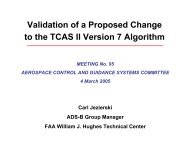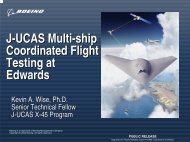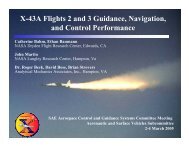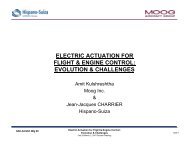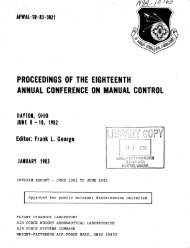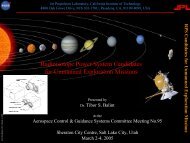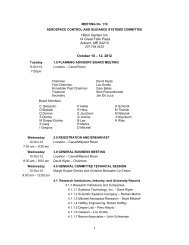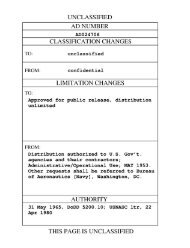Report of the Second Piloted Aircraft Flight Control System - Acgsc.org
Report of the Second Piloted Aircraft Flight Control System - Acgsc.org
Report of the Second Piloted Aircraft Flight Control System - Acgsc.org
Create successful ePaper yourself
Turn your PDF publications into a flip-book with our unique Google optimized e-Paper software.
essentially unobstructed. The flow <strong>of</strong> fluid is <strong>the</strong>n proportional to <strong>the</strong><br />
area <strong>of</strong> <strong>the</strong> valve opening and <strong>the</strong> flow coefficient . At constant flow<br />
coefficient <strong>the</strong>refore <strong>the</strong> piston velocity is directly proportional to<br />
<strong>the</strong> valve opening. With rectangular valve ports <strong>the</strong> open area <strong>of</strong> <strong>the</strong><br />
valve is directly proportional to <strong>the</strong> error <strong>of</strong> <strong>the</strong> piston position. The<br />
velocity <strong>of</strong> <strong>the</strong> piston is consequently proportional to <strong>the</strong> error. In<br />
<strong>the</strong> no load case <strong>the</strong>refore, <strong>the</strong> servomotor will exhibit a traneient<br />
response that is characterized by a linear first order system.<br />
The pressure drop across <strong>the</strong> motor is divided equally between <strong>the</strong><br />
inlet and drain valve ports.<br />
Based on a constant flow coefficient, <strong>the</strong> piston velocity may <strong>the</strong>n<br />
be equated to <strong>the</strong> flow through <strong>the</strong> valve ports by <strong>the</strong>, following relation:<br />
Equation (1) may be written in <strong>the</strong> form<br />
where<br />
The analysis <strong>of</strong> <strong>the</strong> response <strong>of</strong> <strong>the</strong> se~omotor under an inertia<br />
load is considerably more complex than in <strong>the</strong> no load case. Under an<br />
inertia load <strong>the</strong> piston is accelerated from zero velocity. There is<br />
consequently an initial period in <strong>the</strong> response during which <strong>the</strong> flow<br />
through <strong>the</strong>- valve ports is laminar, as a result <strong>of</strong> which <strong>the</strong> flow coef -<br />
ficient is subject to large variations. After <strong>the</strong> piaton hae reached<br />
<strong>the</strong> laaximum velocity in <strong>the</strong> transient, <strong>the</strong> momentum <strong>of</strong> <strong>the</strong> load may<br />
cause <strong>the</strong> flow <strong>of</strong> fluid into <strong>the</strong> upstream side <strong>of</strong> <strong>the</strong> cylinder to cavitate.<br />
The variation <strong>of</strong> <strong>the</strong> pressure drop across <strong>the</strong> piston is <strong>the</strong>refore<br />
not describable by a continuous function and consequently a single differential<br />
equation cannot be written for <strong>the</strong> entire traneient.<br />
In spite <strong>of</strong> <strong>the</strong> complex nature <strong>of</strong> <strong>the</strong> response <strong>the</strong>re are basically<br />
only two phaees in <strong>the</strong> transient: <strong>the</strong> acceleration phase and <strong>the</strong> deceleration'<br />
phase. This conclusion, particularly with reference to a continuous<br />
deceleration phaee without overshoot or oscillat~oii, is baaed<br />
on <strong>the</strong> assumption <strong>of</strong> rigid oil and structure end zero leakage. Under<br />
<strong>the</strong>se assuntptions <strong>the</strong> cylinder pressures during <strong>the</strong> deceleration phase<br />
are finite but may exceed physical limits.



